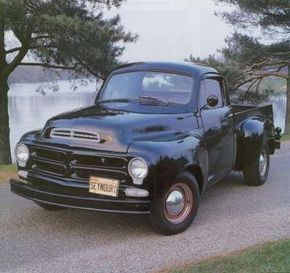1956 Studebaker Truck
The most significant appearance change for Studebaker's 1955 truck was in the large one-piece rear window, which, at 465 square inches, was 40 percent larger than on previous models. In addition, the Studebaker name was emblazoned across the entire width of the hood and headlight rims were enlarged to accommodate the parking lights. A new V-S hood ornament graced the trucks so equipped, while a red "S" was used on the sixes.
External door sun visors were made standard equipment on the line in an apparent effort to make the cabs appear wider. Taking a cue from the public, which in 1955 was buying 80 percent of its new cars in two-tone combinations, Studebaker offered its half-ton in Shasta White and Cherokee Red with a "passenger car" interior trimmed in Shasta White.
Advertisement
The 1956 Studebaker truck got a new name, "Transtar." Though the basic styling dated from 1949, several significant changes were evident. A new, more rounded hood with a large, open "Studebaker" nameplate in the front was the most obvious.
Several new two-tone paint combinations were offered in an eye-catching pattern that distinguished it from anything else on the road. The "Transtar" name was placed on the front edge of the doors. Eight-cylinder models had a V-8 emblem on the back edge of the hood. A "DeLuxe" cab option was offered at $31.82, and those so equipped had the word DeLuxe below the Transtar nameplate.
The pickup box was widened by three inches for 1956, necessitating a new tailgate and rear tread. For the first time, an eight-foot box was also made available on the half-ton. The electrical system was changed from six-volt positive ground to 12-volt negative ground and key starting was adopted. Prior to this, all standard-shift models had the starter button under the clutch. A limited-slip differential, which Studebaker called Twin Traction, was a $26.52 option (the first time any manufacturer had offered this option on a truck). Engine options were essentially the same as in 1955. The 1956 trucks were designated as 2E models.
The R series trucks introduced with such fanfare in the spring of 1948 were the best-selling line in the company's history. In 1949, Studebaker truck registrations were at 5.73 percent of the industry, which was an outstanding accomplishment for the South Bend independent. The trucks were competitively priced, handsome, economical, and had numerous features not available on any competing make. They were a perfect fit for the dealers in small rural communities where truck sales represented a significant portion of the business.
Regrettably, despite all of these encouraging factors, Studebaker was unable to maintain its momentum. Management's lack of a serious commitment to the truck division and market forces beyond its control resulted in a precipitous drop in Studebaker's competitive position. By 1959, Studebaker accounted for approximately one-half of one percent of total truck registrations.
Though Studebaker would continue to find a small niche in the truck market through the 1964 model year, all truck production ceased when the company closed its doors in South Bend in December 1963. The minuscule sales were not adequate to justify production during the last two years of the company's life in Canada.
For more information on different types of cars, see:
- Classic Cars
- Muscle Cars
- Sports Cars
- Consumer Guide Automotive
- Consumer Guide Used Car Search
